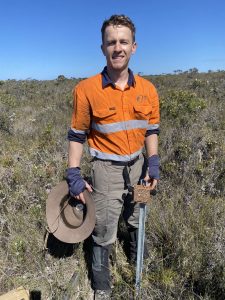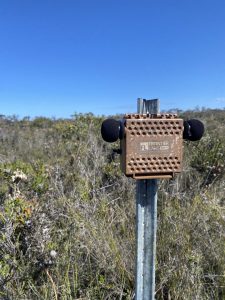

Joseph Jantke, a PhD student at the University of Adelaide, has been provided a grant to assist in his PhD project that involves the conservation of the Western Ground Parrot. The grant will be used to assist in purchasing bioacoustic recorders to assemble acoustic arrays that will be critical for the project.
Introduction:
Conservation efforts for the critically endangered Kyloriny (Western Ground Parrot; Pezoporus flaviventris), like those of many animal species facing extinction globally, suffer greatly from limited monitoring and ecological knowledge due to the species’ rarity and cryptic nature. My project will investigate key knowledge gaps relating to the species’ habitat selection, abundance, population dynamics, and acoustic repertoire using novel monitoring, machine learning, and statistical techniques. Understanding these ecological processes and measures of population dynamics is integral for improving monitoring and management, particularly through improving the efficacy of population monitoring and evaluating the success of management actions. The following research questions will guide the project’s aims and objectives and the investigating of each will constitute my project’s research chapters.
1) Do the captive and wild populations of Kyloriny show variation in call repertoire or vocalisation complexity that may indicate reduced fitness?
2) Can Kyloriny density be predicted temporally and spatially by habitat fire age, floristic community, or vegetation structure?
3) Does the Kyloriny population’s birth rate and adult sex ratio indicate a sustainable population?
The Kyloriny, as it’s known in the indigenous Minang Noongar language, is a critically endangered platycercine parrot once widely distributed along the southwest coast of Western Australia (Burbidge et al. 2016). In 2000, Kyloriny were known to occur in three areas across the south coast of Western Australia: Waychinicup National Park, Fitzgerald River National Park (FRNP), and Cape Arid National Park (CANP) and the adjacent Nuytsland Nature Reserve (NNR). However, a lack of recent records from the Waychinicup area and FRNP indicates the species is now solely found in CANP-NNR. This population is estimated (with low certainty) to contain just 150 birds. The recent extirpations and declines are thought to have occurred due to complex interactions between bushfires and predation by feral predators and likely exacerbated by climate change and vegetation changes imposed by dieback disease (Burbidge et al. 2016).
Kyloriny conservation and management is coordinated through DBCA and the South Coast Threatened Birds Recovery Team, with a BirdLife project officer embedded in the project team. Dedicated research since the late 1980’s has established a good understanding of some aspects of the species’ ecology and biology, and monitoring of population trends has improved since autonomous recording units (ARUs) were incorporated into the recovery program in 2011. However, given the species’ rarity and cryptic nature, knowledge relevant to conservation and monitoring is still lacking. Current population monitoring uses bioacoustic grids and listening surveys to correlate vocal activity with abundance, but the relationship between vocal activity and abundance is unclear, and analysis is hampered by having to manually analyse large amounts of acoustic data (S. Comer pers. Comms.). More powerful analytical techniques could significantly increase the volume of data processed and combined with machine learning, improve the capacity to estimate population size and status.
Methods:
Acoustic data for the project will be collected continuously between May 2025 and May 2027 in CANP-NNR, and vegetation surveys to collect data on habitat covariates will be conducted seasonally. The first research chapter of my project will document a comprehensive acoustic repertoire for wild Kyloriny in CANP and a small captive population in Perth Zoo. Not only is a documented repertoire important for monitoring and behaviour analysis, but the repertoires of the wild and captive populations may be compared to understand whether population decline impacts repertoire and subsequently, fitness (Crates et al. 2021). Existing and new acoustic data will be used to document repertoire in CANP, and ARUs and CCTV footage in Perth Zoo will be used for the captive population. This chapter will be conducted early; a manuscript will be submitted before the end of 2025.
The second chapter of my project will use acoustic spatial capture recapture (aSCR) and an acoustic recogniser to estimate Kyloriny density at various sites in CANP and correlate density with various environmental and habitat covariates. The covariates of interest include vegetation fire age, vegetation structure (floristics), vegetation composition, microclimate (temperature and humidity), and climatic data. The impact of additional landscape covariates collated using GIS or remote sensing techniques such as vegetation density indices or slope will also be analysed. A small acoustic array of three ARUs (Frontier Labs Bar-V2 recorders) will constitute each recording site, and these sites are stratified according to vegetation fire age, the variable hypothesised to exert the greatest influence over Kyloriny density. Two sites will be established in each of five vegetation fire ages for a total of 10 sites and 30 ARUs (Figure 1). A convolutional neural network (CNN) developed last year for Kyloriny will be improved to efficiently analyse the large amounts of recording data. The aSCR methodology will be adapted from work by and with the support of a supervisor of the project (Stevenson et al. 2021).
The final chapter will measure population viability using estimates of birth rate and adult sex ratio (ASR). Population demography and breeding are two aspects of Kyloriny ecology that have eluded concerted investigation since the species was first studied – a Kyloriny nest with a live clutch has not been observed since 1913. A CNN recogniser trained on juvenile and hatchling calls will be used to estimate breeding success and Kyloriny birth rate. A separate CNN recogniser developed with transfer learning (Ghani et al. 2023) will generate audio embeddings of male and female calls that will be visualised and clustered with a dimensionality reduction (DR) algorithm (Best et al. 2023) to estimate ASR.